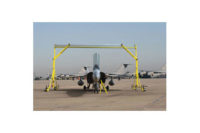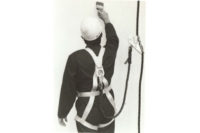Problems preventing falls
Throughout 2014, ISHN will report in each issue on one of the 12 most frequently cited OSHA standards, for fiscal year 2013, ending September 30, 2013.
$19,345,818 Total penalty amount proposed by OSHA for the number-one most frequently cited standard in fiscal year 2013 (October 2012 through September 2013) 1926.0501 – duty to have fall protection in all industries.
7,704 Number of total citations
7,449 Number of total inspections
$18,924,845 Total penalty amount assessed in the construction industries
7,530 Number of citations in the construction industries
7,282 Number of inspections in the construction industries
$16,384,714 Total penalties assessed to Specialty Trade Contractors
6,419 Number of citations to Specialty Trade Contractors
6,229 Number of inspections of Specialty Trade Contractors
$2,246,920 Total penalties assessed to Construction of Buildings
1,043 Number of citations assessed to Construction of Buildings
990 Number of inspections of Construction of Buildings
Other industries CITED
$111,374 total penalties
Wholesale Trade
$102,378 total penalties Manufacturing
$51,352 total penalties Waste Management and Remediation Services
Winter weather alert
Every year, workers are killed or seriously injured while performing snow or ice removal from rooftops and other building structures, such as decks. OSHA has investigated 16 such serious injuries or fatalities in the past 10 years – all of which could have been prevented.
Fatality cases
9/30/2013 - Skanska, Holbrook, AZ 86025 - Worker died after fall from the deck of a bridge under construction.
9/29/2013 - Mega Construction Co. Inc., Daphne, AL 36526 - Worker died after a fall on construction site.
6/29/2012 - Williams Warehouse Inc., Plains, GA 31780 - Employee died after falling from a roof through a skylight while removing metal panels.
9/20/2012 - Bonneville Power Administration, Saint Regis, MT 59866 - Worker died after falling approximately 80 feet while replacing insulators.
2012 - KAYCO Erectors Inc., Sugar Hill, GA 30518 - Employee died after falling through floor hole while installing metal decking.
2012 - Russell Toll dba Toll Roofing and Repair, Maysville, KY 41018 - Worker installing a tarp on a roof of a hotel stepped on the eave which collapsed resulting in worker falling approximately 26 feet onto parking lot.
9/2/2012 - GreenTek Roofing, Carnigie, PA 15106 - Worker died after falling from a roof.
8/22/2012 - Aireko Construction Corporation, Caguas, PR 00725 - Worker fell 17 feet through a metal roof landing on a concrete floor.
2012 - ZIA Construction and Contracting Inc., Cheney, WA 99004 - Worker sheeting the roof on a two-story building suffered fatal head injuries after falling 21 feet to the ground.
8/27/2012 - Edwards Construction Inc., Rock Hill, SC 29732 - Worker preparing to cut tree limbs died after falling 40 feet to ground.
What the standard says (excerpts):
1926.501(a)(2)
The employer shall determine if the walking/working surfaces on which its employees are to work have the strength and structural integrity to support employees safely. Employees shall be allowed to work on those surfaces only when the surfaces have the requisite strength and structural integrity.
1926.501(b)(1)
“Unprotected sides and edges.” Each employee on a walking/working surface (horizontal and vertical surface) with an unprotected side or edge which is 6 feet (1.8 m) or more above a lower level shall be protected from falling by the use of guardrail systems, safety net systems, or personal fall arrest systems.
1926.501(b)(4)(i)
Each employee on walking/working surfaces shall be protected from falling through holes (including skylights) more than 6 feet (1.8 m) above lower levels, by personal fall arrest systems, covers, or guardrail systems erected around such holes.
1926.501(b)(4)(ii)
Each employee on a walking/working surface shall be protected from tripping in or stepping into or through holes (including skylights) by covers.
1926.501(b)(13)
“Residential construction.” Each employee engaged in residential construction activities 6 feet (1.8 m) or more above lower levels shall be protected by guardrail systems, safety net system, or personal fall arrest system unless another provision in paragraph (b) of this section provides for an alternative fall protection measure. Exception: When the employer can demonstrate that it is infeasible or creates a greater hazard to use these systems, the employer shall develop and implement a fall protection plan which meets the requirements of paragraph (k) of 1926.502.
Lost lives and days away from work
751
In 2010, the Bureau of Labor Statistics (BLS) reported that 751 construction workers died on the job, with 35 percent of those fatalities resulting from falls.
1,153,980
Incidents requiring days away from work 2012 (according to the U.S. Bureau of Labor Statistics)
Of the 443,560 sprain, strain, and tear cases reported in 2012, falls, slips, and trips accounted for 23 percent.
For fractures, the median increased by 3 days to a median of 30 days. Fractures were primarily the result of falls on the same level (31 percent). Fractures from falls on the same level required a median of 30 days away from work.
219,630
Days away from work cases in 2012 due to falls, slips or trips (BLS)
668
Fatalities due to falls, slips or trips in 2012 (BLS)
What can be done to reduce falls? (according to OSHA)
? Guard every floor hole into which a worker can accidentally walk (using a railing and toe-board or a floor hole cover).
? Provide a guardrail and toe-board around every elevated open
sided platform, floor or runway.
? If a worker can fall into or onto dangerous machines or equipment, employers must provide guardrails and toe-boards.
? Other means of fall protection that may be required on certain jobs include safety and harness and line, safety nets, stair railings and hand rails.
OSHA requires employers to:
? Provide working conditions that are free of known dangers.
? Keep floors in work areas in a clean and, so far as possible, a dry condition.
? Select and provide required personal protective equipment at no cost
to workers.
? Train workers about job hazards in a language that they can understand.
Information on Fall Protection
Personal fall arrest systems and guardrails are among the most commonly used forms of fall protection for work on roofs.
Typical personal fall arrest systems involve an anchor point, a full-body harness, and a connector, such as a retractable lifeline or a shock-absorbing lanyard. Anchor points must be able to support at least 5,000 pounds for each worker attached to it (1926.502(d)(15)) or maintain a safety factor of at least two (twice the impact load) under the supervision of a qualified person (1926.502(d)(15)(i) and (ii)).
Fall Protection solutions sponsor:
1-800-821-0086





